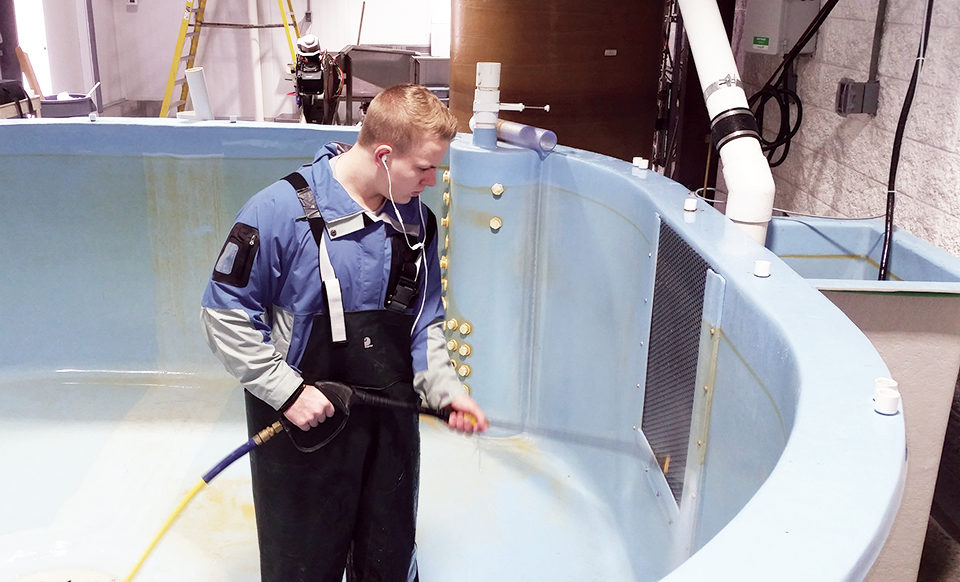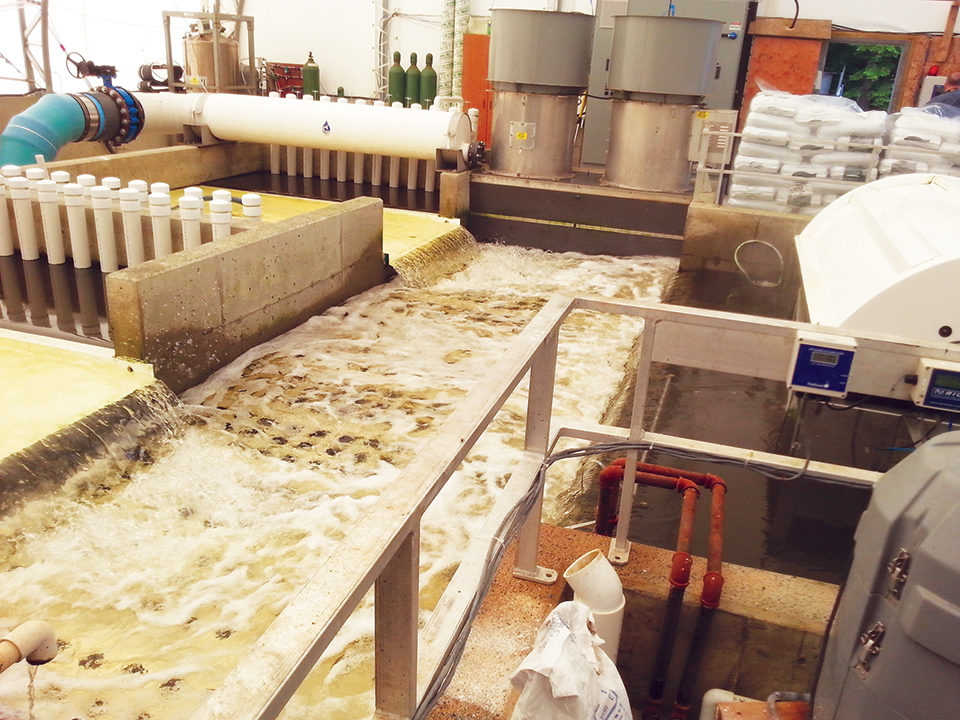Closed-containment culture advances

At The Conservation Fund Freshwater Institute (TCFFI), the authors are working to develop land-based closed-containment technologies that cost-effectively increase farmed fish production while excluding obligate fish pathogens, minimizing water input and meeting point source discharge limits. Existing aquaculture operations are demonstrating that land-based closed-containment technology is adequate for the production of salmon smolts, as well as caviar and many varieties of food fish.
The benefits that are being realized by increased biosecurity and strict control of the rearing environment – including enhanced fish growth, product quality and survival, as well as reduced vaccination and treatment costs – have made the closed-containment approach an important emerging trend. However, additional improvements are still required to optimize fish production, mitigate off-flavors, reduce discharges, cut costs and further enhance biosecurity.
Focus on biosecurity
Fish farmers are recognizing the biosecurity threat posed by the use of surface water and are shifting away from this water source to avoid pathogen transfer from wild fish populations. In addition, more smolt/post-smolt/growout farms are transitioning to recirculating aquaculture systems (RAS) to minimize water flushing so that sophisticated filtration and ultraviolet irradiation can be used to disinfect makeup water, when necessary.
Just as importantly, fish farms are attempting to introduce only specific pathogen-free eggs, when possible, and are also avoiding the introduction of fish potentially infected with pervasive pathogens. If farms can exclude obligate fish pathogens, the result is consistently healthier fish, reduced mortality and improved performance compared to more open systems.
Excluding pathogens can also reduce or eliminate vaccine, antibiotic and pesticide use and avoid losses in growth and survival, as well as the costs of mitigation techniques. TCFFI, for example, uses a relatively biosecure groundwater source and introduces only disinfected eggs from broodstock populations tested negative for listed pathogens. In addition, trained staff and standard biosecurity practices have allowed the facility to avoid the use of vaccines, antibiotics and organic pesticides for over 10 years, while producing approximately 20 (metric tons) MT of salmonids annually.
Economies of scale
As the closed-containment industry has developed, a trend toward increasing the scale of both growout and smolt/post-smolt facilities has emerged. Improved technologies and economies of scale provide farmers with energy-efficient and capital cost-efficient systems to produce more fish, which means higher profits and better operational control.
The impacts of improving water treatment technology on fixed and variable costs can be profound due to the magnitude of system scale. For example, 1,000 MT/year of salmonid production requires recirculating water flows of 11,000 to 16,000 cubic meters per hour to maintain water quality while feeding 4-5 MT/day, but less than 80 cubic meters per hour of makeup water. This reflects about 99.5 percent flow reuse.
Some new Atlantic salmon smolt and/or post-smolt farms, in Norway in particular, are orders of magnitude larger in production scale than this example. Some of the large salmon-farming companies simply refer to their RAS as “smolt-producing machines.”

Growout on land
Land-based salmon growout received positive news in January, as a committee appointed by the Norwegian Ministry of Fisheries concluded that no license fees or quotas should be required for land-based salmon production in Norway. The final permitting for land-based salmon growout from the Norwegian ministry could take another year, but at least the process looks to have started. These new developments are expected to provide a strong market incentive that costs the government nothing, but makes it more attractive to raise salmon in land-based systems.
Although not yet producing salmon in this manner, at least one company plans to produce food-size salmon in land-based systems in Norway. It has been waiting for a special research and development permit to develop large on-land salmon production. This might encourage other salmon-farming companies to consider producing on land in Norway, as there is currently strong competition for new net pen licenses, which can cost NOK 60 million (about $10 million) per license.
As an advantage, the existing farms have the infrastructure in place that would make it easier and more cost-effective to add land-based salmon growout to their production portfolios. This infrastructure often includes pre-existing marketing and distribution channels, processing facilities, smolt facilities and staff with prior RAS experience. Some of the largest salmon producers also have their own broodstock and feed mills, all of which should combine to give them an advantage over startup farms that have to develop much of this from scratch.
Trials continue

TCFFI is now working on its fifth and sixth trials evaluating growout of Atlantic salmon to food size of 4 to 6 kg in land-based closed-containment systems. To conclude the fifth trial, the authors will begin harvesting 5-kg mean size salmon in late February, at approximately 25 months post-hatch. The fish in the sixth trial will be harvested in early 2016.
Detailed metrics on performance, survival, feed conversion, fillet yield, condition factor and water quality are available on the Tides Canada website. More details will be provided in a forthcoming manuscript.
Salmon from the TCFFI closed-containment system have received excellent reviews from consumers and seafood distributors. The fish have many market advantages, including the fact they are produced locally and available fresh. No pesticides or antibiotics were used during production. Ranked a “Best Choice” by the Monterey Bay Aquarium Seafood Watch program, the salmon are also traceable.
All of these qualities can be used to market and brand the product. In addition, well-run commercial farms will typically have the advantage of consistent production with a similar product every week of the year.
The authors have also learned that careful consideration must be given to minimizing the early maturation of male salmon and depurating the harvested salmon to purge an earthy flavor produced by bacteria in the RAS. At TCFFI, food-size salmon are purged for at least one week during the finishing phase. Early maturing males represent about 20 percent of the population. These fish are harvested at about 2-kg weight and often sold as a hot-smoked product. The facility looks forward to the arrival of a commercial source for all-female Atlantic salmon, which could become available in the winter of 2015.
(Editor’s Note: This article was originally published in the March/April 2015 print edition of the Global Aquaculture Advocate.)
Authors
-

Steven Summerfelt, Ph.D.
The Conservation Fund
Freshwater Institute
1098 Turner Road
Shepherdstown, West Virginia 25443-4228 USA -

John Davidson, M.S.
The Conservation Fund Freshwater Institute
-

Travis May
The Conservation Fund Freshwater Institute
-

Christopher Good, DVM, Ph.D.
The Conservation Fund Freshwater Institute
-

Brian Vinci, Ph.D.
The Conservation Fund Freshwater Institute
Tagged With
Related Posts

Responsibility
Emerging trends in salmonid RAS, part 2
Dozens of land-based, closed-containment salmonid RAS systems are coming on line. New projects are bringing new principles into the salmon industry. Industry expansion hinges upon the development of pollution-mitigating technologies to reduce nutrients in effluents.

Innovation & Investment
AquaBounty, with new RAS facility, hopes to win public support for GM salmon
Ron Stotish, CEO of AquaBounty Technologies, believes genetically modified salmon is no threat to its opponents and the outlook for AquAdvantage is good. With its purchase of the Bell Fish Co. RAS facility, commercialization will soon commence.

Innovation & Investment
Competitiveness comes at scale for RAS operations
Total RAS salmon production worldwide is less than half of 1 percent of total production. Many of the investors flocking to the sector now are new to fish farming, and confident in its potential.

Innovation & Investment
Getting proficient in RAS fundamentals
A number of large salmon farming companies are now investing significantly to increase land-based, water recirculating aquaculture systems (RAS) in northern Europe and North America, and there is likely a need for more trained farm personnel to run and manage these and other close-containment aquaculture facilities.

